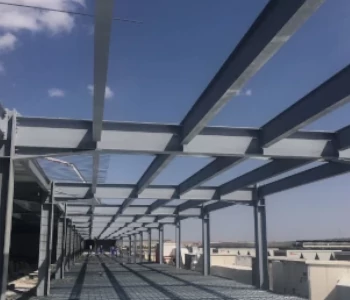-
Call Us +971 67657121
-
Send Message [email protected]
-
Our Location UMM DEARA, AL TAWOON NEW INDUSTRIAL AREA, UMM AL QUIWAN
Structural Fabrication
Structural Fabrication

Structural fabrication is a detailed process that involves the creation of metal structures through techniques such as cutting, bending, and assembling raw steel into meticulously designed components. These components, which include elements such as beams, trusses, and columns, are engineered to meet specific load and design requirements. Once fabricated, these parts are transported to construction sites, where they are assembled to form the framework of various infrastructures. This process is crucial for the development of diverse structures, ranging from towering skyscrapers and expansive bridges to complex industrial facilities. The precision in structural fabrication ensures that these components not only fit together perfectly but also adhere to safety regulations and standards, ultimately contributing to the durability and stability of the constructed environment
The Structural Fabrication Process
Structural fabrication encompasses a series of critical steps designed to guarantee both precision and quality in producing components that can endure significant loads and harsh environmental conditions. This intricate process transforms raw steel into durable structures utilised across various industries, including construction, manufacturing, and infrastructure.
-
Design and Detailing: The initial phase involves design engineers utilising advanced computer-aided design (CAD) software to create comprehensive plans and detailed shop drawings. These documents outline vital specifications, including structural dimensions, load-bearing capacities, and material properties. This stage is crucial, as a well- thought-out design ensures that the final product meets all performance criteria and standards.
-
Material Preparation: Following the design phase, raw steel material is procured according to project requirements. This steel may come in various forms, including plates, sheets, or structural sections. Prior to fabrication, the selected material undergoes meticulous quality control inspections to eliminate any defects and ensure it meets industry standards, such as ASTM specifications.
-
Cutting and Drilling: The prepared steel is then processed through precise cutting techniques. Methods such as shearing, plasma cutting, laser cutting, and water jet cutting are employed to achieve accurate shapes and sizes based on the specifications outlined in the design drawings. After cutting, necessary holes are drilled to accommodate bolts and fasteners, enhancing the structural integrity of the final assembly.
-
Bending and Forming: In this stage, fabricators employ sophisticated machinery, such as hydraulic brake presses and roll forming machines, to bend or roll the steel into specified geometric shapes. This may involve creating curves, angles, or custom configurations necessary for the project. For unique or complex shapes, manual hammering techniques might also be used to achieve the desired results, ensuring a tailored fit for each component.
-
Assembly and Welding: Once all components are fabricated, they are brought to the assembly area within the fabrication facility. Here, pieces are meticulously fitted and aligned according to the design specifications. The assembly process often includes tack welding, where pieces are temporarily joined for strength. The final welding is then performed by certified welders, ensuring that the connections are robust and comply with structural engineering standards. Distinguishing between fabrication and welding is crucial, as welding represents a specific joining technique within the broader context of the fabrication process.
-
Finishing: To enhance the longevity and durability of the fabricated components, a variety of protective coatings are applied. Common finishing processes include painting, powder coating, and galvanising, each tailored to provide resistance against corrosion and environmental degradation. The choice of finish depends on the intended use of the structure and the conditions it will face.
-
Quality Control: The final stage involves rigorous quality control measures. Each fabricated component undergoes stringent inspections and testing protocols to verify compliance with project specifications and safety regulations. These assessments might include dimensional checks, weld inspections, and material stress testing. Only after passing these evaluations are the components approved for shipment to the construction site, ensuring that they meet the highest standards of safety and performance.
Applications of Structural Fabrication
Fabricated steel components are integral to a diverse range of industries, celebrated for their exceptional durability and strength.
-
Construction: In the realm of construction, fabricated steel forms the backbone of towering high-rise buildings, majestic bridges, and expansive infrastructure projects. These robust materials are engineered to withstand the test of time and the forces of nature, ensuring safety and stability.
-
Industrial: In industrial settings, fabricated steel is essential for the creation of expansive warehouses, state-of-the- art factories, and critical oil and gas plants. Its reliability and strength make it the ideal choice for power generation facilities, where safety and efficiency are paramount.
-
Architectural: Architects harness the versatility of steel to bring their creative visions to life. From sweeping staircases that draw the eye to elegant canopies and intricately designed handrails, fabricated steel allows for both aesthetic beauty and structural integrity, transforming spaces into functional works of art.
-
Equipment: The manufacturing sector relies heavily on fabricated steel for producing heavy machinery and mining equipment, as well as a wide array of specialized tools. These components are designed for resilience and precision, enabling industries to operate efficiently in the most demanding environments.
-
Infrastructure: Fabricated steel plays a crucial role in the development of vital infrastructure, including pipelines that transport essential resources, sturdy transmission towers that support electrical grids, and the transportation networks that connect communities. Its applications promote connectivity and support the backbone of modern civilization.

